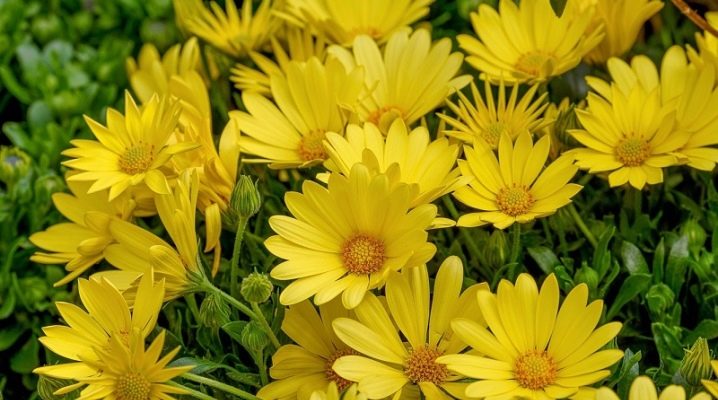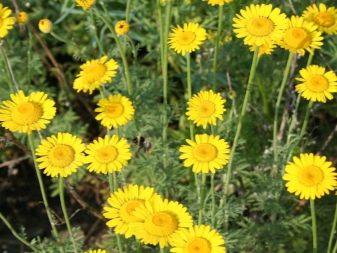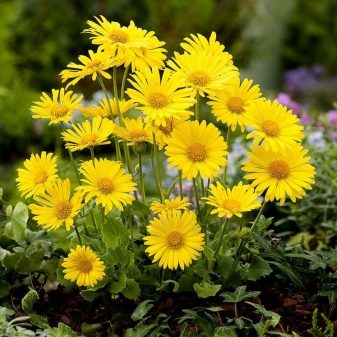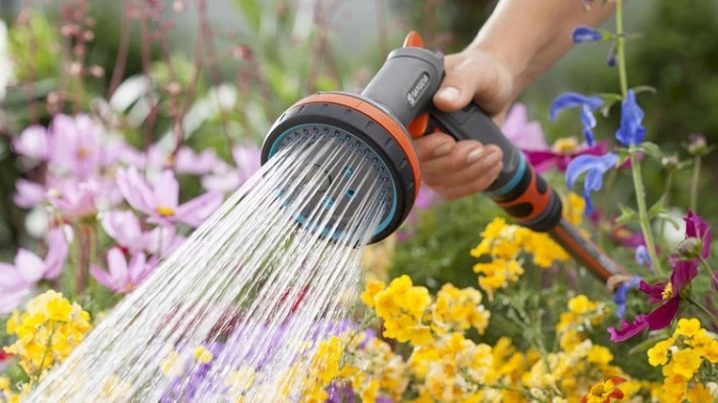Yellow daisies

Yellow daisies are cute compact flowers that can be used to make a unique variegated composition in the garden. Interestingly, many flowers are popularly called yellow daisies. It is worthwhile to understand in more detail which plants are actually yellow daisies, and which only resemble them.


Doronicum and its description
Doronicum is a true yellow chamomile that is a perennial plant. The flower is included in the aster group, is distinguished by its simplicity and unpretentiousness in care, as well as rather rapid growth. Suitable for planting in the garden, therefore it is in demand among florists and landscape designers. Doronicums are small flowers of a rich yellow hue, which from the first seconds attract the eye and make the composition more juicy.
Main characteristics:
- height - from 30 cm to 1 m;
- the shape of the flowers is small suns;
- the color of the petals is rich yellow;
- the core is fluffy.
Outwardly, the doronicum resembles a nivyanik, the only difference is the smaller and at the same time voluminous petals. The leaf plates of the culture are small, there are few of them, they grow on the stem alternately. Today, the doronicum has over 40 species, but only a quarter of the total is found in gardens.


Here are the most common ones.
- Eastern doronicum. The variety got its name due to the place where it is found. Among the features of the variety, the early flowering period and the non-standard structure of the leaves are distinguished, which are devoid of fluffiness and have a smooth surface.

- Yellow chamomile... A direct subspecies, which is characterized by large inflorescences and dark green leaves, reminiscent of plantain leaf plates.

- Altai doronicum. The key feature of the variety is its small flowers and large leaf blades, which gives a unique combination and makes the flower in demand among landscape designers.

Most varieties have increased resistance to external influences and quickly take root even in harsh conditions. Yellow daisies bloom for a long time, which is one of the advantages of the popular flower. On average, the plant pleases the owners of the garden with colorful buds throughout the spring and the first month of summer, until the extreme heat comes.
It is quite simple to grow doronicum in a garden plot, since the culture quickly takes root even in infertile soils. Florists identify several methods for propagating a popular flower.
- Seeds... A common method that involves the use of dried yellow chamomile bolls, which are cut and dried on the windowsill before sowing in open ground. Before planting, the seeds must be removed from the head.
- Cuttings... The second most popular method. The very next year after planting the cuttings, chamomile will delight you with bright yellow buds.
- Root sections... Among the advantages of doronicum, a powerful root system is distinguished, which can be used to reproduce a flower. To achieve the desired result, you will need to move part of the soil with chamomile roots to another place on the site.


After planting, it is worth taking care of the care of the plant. Basically, a flower requires sun and water. Therefore, it is important to organize timely and abundant watering, as well as choose a sunny site for planting a future culture.
Fertilizers are optional.If desired, before planting seeds in open ground, you can saturate the soil with useful components, and also apply a small amount of fertilizer when the flower starts growing and begins to form buds.

Pupavki and their features
A separate group is to highlight the navel - this is a perennial herb that looks like a yellow chamomile, but in fact it is not. Among the features of the navel are:
- rather large inflorescences of rich yellow color, up to 6 cm in diameter;
- erect stems with a maximum height of 100 cm;
- large leaf plates, the surface of which is covered with a small fluff.
The umbilical dye, also known as antemis, is especially similar to the field daisy. The marginal flowers of the variety go in several rows, along which they distinguish the culture from yellow chamomile. The duration of flowering at the terry navel is short, it begins to release flowers around the beginning of summer. In the wild, it occurs:
- in fields and meadows;
- in the forest;
- along the roadsides.


In most regions, variegated navel is a weed that is not particularly popular with both flower growers and landscape designers. However, some gardeners still use the culture as a decorative decoration of the site. Among the advantages of a navel, it is worth noting unpretentiousness in care and adaptability even to harsh conditions. For example, in some regions, the navel can withstand temperatures as low as -30 degrees Celsius.
The flower got its name due to the coloring substances contained in the petals. Previously, the plant was actively used to give fabrics a yellow or lemon hue.
Today, the weed is used for the manufacture of insecticidal preparations, with the help of which it is possible to organize effective pest control.

Other yellow flowers similar to chamomile
Yellow chamomile is a flower with which you can easily confuse other plants that produce small sun-shaped buds of a bright shade. It's worth starting with the chamomile itself, which has a myriad of different varieties.
- Tongueless... The flower has erect stems, whose height reaches 40 cm. The leaf plates are dissected, saturated green. Closer to the beginning of flowering, chamomile forms small baskets.

The listed varieties have nothing to do with annual or perennial yellow chamomile, with which they are surprisingly confused. And also with this flower varieties of daisy are often compared.
- Goldfinch... The spring flower produces semi-double type buds with small and thin petals of a pleasant yellow hue. The shape of the buds is tubular, the height of the stems reaches 60 cm.

- Banana cream. It is not difficult to guess from the name what color the buds are formed by the plant. Among the features, semi-double inflorescences with reed petals are distinguished, which immediately attract attention with their yellow tint. Interestingly, the variety subsequently fades to an ivory shade, leaving only the middle yellow.

- Nivyanik... A large flower that produces huge yellow buds, by which it will be possible to distinguish a plant from a yellow chamomile. It grows mainly in fertile soils and in sunny meadows, therefore it is difficult to attribute the daisy to weeds.

- Heliopsis is astral. A pretty flower that rises to a height of 1.6 m. Characteristics include oblong leaf plates and tubular inflorescences in the middle of the stem. The plant forms buds of a yellow or brownish hue, orange petals appear closer to the edge.


And also often helenium is confused with yellow chamomile.
Yellow chamomile is a flower in demand in landscape design, which is often confused with other plants. Therefore, it is important to understand the variety of crops and varieties in order to plant what you need on the garden plot.








































































































The comment was sent successfully.